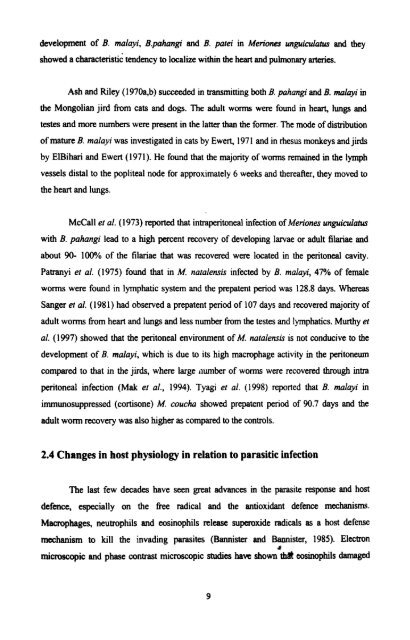effect of infection of the filarial parasite brugia malayi - Pondicherry ...
effect of infection of the filarial parasite brugia malayi - Pondicherry ...
effect of infection of the filarial parasite brugia malayi - Pondicherry ...
Create successful ePaper yourself
Turn your PDF publications into a flip-book with our unique Google optimized e-Paper software.
development <strong>of</strong> B. <strong>malayi</strong>, B.pahangi and B. patei in Menones unguiculatus and <strong>the</strong>y<br />
showed a characteristid tendency to localize within <strong>the</strong> heart and pulmonary arteries.<br />
Ash and Riley (1970a,b) succeeded in transmitting both 5. pahangi and B. <strong>malayi</strong> in<br />
<strong>the</strong> Mongolian jird from cats and dogs. The adult worn were found in heart, lungs and<br />
testes and more numbers were present in <strong>the</strong> latter than <strong>the</strong> former. The mode <strong>of</strong> distribution<br />
<strong>of</strong> mature B. <strong>malayi</strong> was investigated in cats by Ewert, 1971 and In rhesus monkeys and jirds<br />
by ElBihari and Ewert (1971). He found that <strong>the</strong> majority <strong>of</strong> worms remained in <strong>the</strong> lymph<br />
vessels distal to <strong>the</strong> popliteal node for approximately 6 weeks and <strong>the</strong>reafter, <strong>the</strong>y moved to<br />
<strong>the</strong> heart and lungs.<br />
McCall et 41. (1973) reported that intraperitoneal <strong>infection</strong> <strong>of</strong> Meriones unguiculatus<br />
with B. pahangi lead to a high percent recovery <strong>of</strong> developing larvae or adult filariae and<br />
about 90- 100°/o <strong>of</strong> <strong>the</strong> filariae that was recovered were located in <strong>the</strong> peritoneal cavity.<br />
Pabanyi et al. (1975) found that in M. natalensis infected by 5. <strong>malayi</strong>, 47% <strong>of</strong> female<br />
worms were found in lymphatic system and <strong>the</strong> prepatent period was 128.8 days. Whereas<br />
Sanger et al. (1981) had observed a prepatent period <strong>of</strong> 107 days and recovered majority <strong>of</strong><br />
adult worms from heart and lungs and less number from <strong>the</strong> testes and lymphatics. Murthy et<br />
41. (1997) showed that <strong>the</strong> peritoneal environment <strong>of</strong> M. natalensis is not conducive to <strong>the</strong><br />
development <strong>of</strong> B. <strong>malayi</strong>, which is due to its high macrophage activity in <strong>the</strong> peritoneum<br />
compared to that in <strong>the</strong> jirds, where large ~x.unber <strong>of</strong> worms were recovered through intra<br />
peritoneal <strong>infection</strong> (Mak et al., 1994). Tyagi et 01. (1998) reported that 5. <strong>malayi</strong> in<br />
immunosuppressed (cortisone) M, coucha showed prepatent period <strong>of</strong> 90.7 days and <strong>the</strong><br />
adult worm recovery was also higher as compared to <strong>the</strong> controls.<br />
2.4 Changes in host physiology in relation to parasitic <strong>infection</strong><br />
The last few decades have seen great advances in <strong>the</strong> <strong>parasite</strong> response and host<br />
defence, especially on <strong>the</strong> free radical and <strong>the</strong> antioxidant defence mechanisms.<br />
Mamphages, neutrophils and eosinophils nlease supemxide radicals as a host defense<br />
mechanism to kill <strong>the</strong> invading <strong>parasite</strong>s (Bannister and Bannister, 1985). Electron<br />
4<br />
microscopic and phase contrast microscopic studies have shown th& eosinophils damaged

















